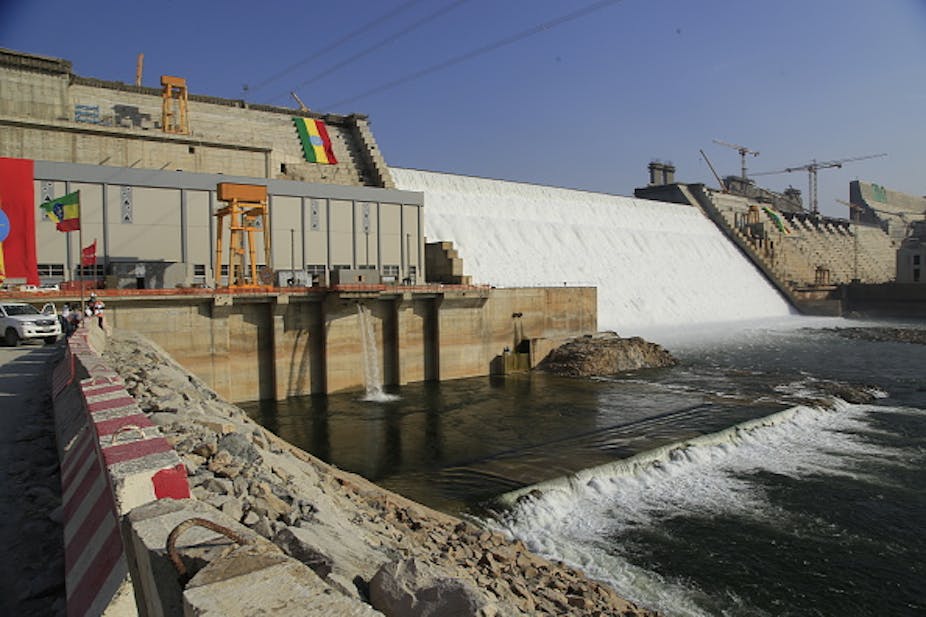Egypt and Ethiopia have waged a diplomatic war of words over Ethiopia’s massive new dam – the Grand Ethiopian Renaissance Dam – on the Blue Nile, which started filling up in July 2020. The political row has threatened to get out of hand on occasion but now the two countries have finally agreed to conclude “a mutually acceptable agreement” within four months. We asked John Mukum Mbaku, the author of a recent article on the Ethiopian dam and a co-author of a book on the Nile River’s changing legal regime, to answer four key questions.
What is the context of the current tussle?
Ethiopia, whose highlands provide more than 85% of the water that flows into the Nile, has long argued that it has the right under international law to manage resources within its own borders for its national development. It sees the “Nile as a gift of God” given to Ethiopians to use for their development.
Egypt, which depends on the Nile for more than 90% of its fresh water, has argued that the Ethiopian dam represents a threat to its water security and its very existence as a people.
The decision by Addis Ababa to begin construction of the dam on the Blue Nile in 2011 exacerbated an already deteriorating relationship between Ethiopia and its two downstream neighbours, Egypt and Sudan, over access to Nile waters. After Egypt’s diplomatic efforts failed to stop construction, Cairo redirected its energies to securing a legally binding agreement for filling and operating the dam.
But no mutually acceptable agreement for filling and operating the dam was ever reached.
In August 2020, Addis Ababa began to fill the dam’s reservoir. That process was repeated in 2021 and 2022.
In 2023, Ethiopian prime minister Abiy Ahmed announced that the country would delay the fourth filling until September “to alleviate the concerns of neighbouring people”.
The dam’s reservoir filling in particular, and its operation in general, are issues that the three countries must resolve, most likely through a legally binding agreement or treaty.
In February 2022, the Ethiopian dam started producing electricity. Egyptians claimed that Addis Ababa was “violating its obligations under the 2015 Declaration of Principles” and endangering Egyptian “water interests”.
What are the main sticking points going into the talks?
An agreement would have to explicitly deal with issues that are important to Egypt, Ethiopia and Sudan. The most important are Egypt’s and Sudan’s historically acquired rights to Nile waters. The rights were granted by the 1929 Anglo-Egyptian Treaty and the 1959 bilateral agreement between Egypt and Sudan (1959 Nile Treaty).
After estimating the average annual flow of the Nile River as measured at Aswan to be 84 billion cubic metres, the two treaties granted 66% of Nile waters to Egypt, 22% to Sudan and 12% to account for seepage and evaporation. These allocations exhausted all the Nile’s average annual flow of water. Egypt was also granted veto power over all construction projects on the Nile and its tributaries.
These rights came to be known as Egypt’s and Sudan’s acquired rights. They have been the main sticking point in efforts to conclude a treaty between all 11 Nile riparian states for the allocation of the waters of the Nile, as well as between Egypt, Ethiopia and Sudan over the Ethiopian dam.
While Ethiopia and other upstream riparian states see these two treaties as colonial anachronisms that have no relevance to modern Nile governance, Egypt and Sudan insist that they are binding.
What impact would a breakthrough have on other Nile Basin agreements?
The impact will depend on what type of agreement is reached. Assume that both Egypt and Sudan agree to abandon the rights granted by the 1929 and 1959 treaties. They could then enter into negotiation with Ethiopia to produce a new treaty that creates rights for all three states.
Such a treaty could provide the impetus for all 11 Nile Basin states to return to the Cooperative Framework Agreement, which was expected to provide a legal framework for governing the Nile based on equitable and reasonable water use. The framework agreement has been in limbo since Egypt and Sudan rejected it.
The other Nile Basin states see these colonial-era treaties as a violation of international law principles, and a breach of the vision of the Nile Basin Initiative.
What other claims threaten the status quo?
Egypt fears that if Addis Ababa is allowed to fill the reservoir without a legally binding agreement, other Nile Basin states might also take unilateral actions. This could harm Egypt’s water security and ability to control projects on the Nile River and its tributaries.
Then, there is the matter of how to manage issues related to climate change, such as droughts and floods. The existence of the dam means Addis Ababa’s cooperation will be required. In times of drought, for example, the Ethiopian dam will be expected to release some water to help Egypt and Sudan.
Ethiopia’s right to water for agriculture and household consumption is an issue that has not yet been agreed upon by all three countries.
Egypt and Sudan are worried about the harm that could come to them from activities upstream. Egypt remains adamant that the dam will hurt its water supply and threaten domestic development.
But Sudanese officials appear to have changed their assessment of the impact of the dam. They now see it as a potential regulator of seasonal floods and provider of clean energy.
These issues should be examined thoroughly during the negotiations. The three countries should adopt a treaty or agreement that is mutually acceptable and beneficial.
Over the years, the three countries have struggled to bring meaning to terms like “significant harm” and “equitable and reasonable utilisation”. The final treaty should define these terms. It should also create a mediation mechanism, which can include referring certain specified matters to the International Court of Justice for resolution.

